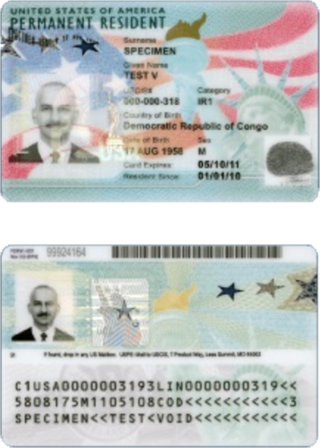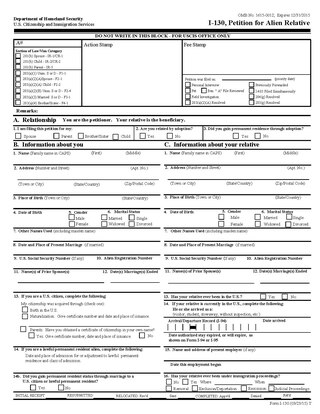Related Research Articles

A green card, known officially as a permanent resident card, is an identity document which shows that a person has permanent residency in the United States. Green card holders are formally known as lawful permanent residents (LPRs). As of 2019, there are an estimated 13.9 million green card holders, of whom 9.1 million are eligible to become United States citizens. Approximately 65,000 of them serve in the U.S. Armed Forces.
TN status is a special non-immigrant classification of foreign nationals in the United States, which offers expedited work authorization to a citizen of Canada or a national of Mexico. It was created as a result of provisions of the North American Free Trade Agreement that mandated simplified entry and employment permission for certain professionals from each of the three NAFTA member states in the other member states. The provisions of NAFTA relevant to TN status were then carried over almost verbatim to the United States–Mexico–Canada Agreement that replaced NAFTA in 2020.
The V visa is a temporary visa available to spouses and minor children of U.S. lawful permanent residents. It allows permanent residents to achieve family unity with their spouses and children while the immigration process takes its course. It was created by the Legal Immigration Family Equity Act of 2000. The Act is to relieve those who applied for immigrant visas on or before December 21, 2000. Practically, the V visa is currently not available to spouses and minor children of LPRs who have applied after December 21, 2000.

The visa policy of the United States consists of the requirements for foreign nationals to travel to, enter, and remain in the United States. Visitors to the United States must obtain a visa from one of the U.S. diplomatic missions unless they come from one of the visa-exempt or Visa Waiver Program countries. The same rules apply for travel to all U.S. states, Washington, D.C., Puerto Rico and the U.S. Virgin Islands, as well as to Guam and the Northern Mariana Islands with additional waivers, while similar but separate rules apply to American Samoa.
In the United States, the F visas are a type of non-immigrant student visa that allows foreigners to pursue education in the United States. F-1 students must maintain a full course of study. F-1 visas are only issued in U.S. embassies and consulates outside the United States, although extensions of stay and changes of status may be possible within the United States. Prospective F-1 students must apply at the schools and receive a form I-20 in order to apply for an F-1 visa. F-1 students must show that they are able to support themselves during their stay in the U.S., as their opportunities for legal employment are quite limited. F-2 visas are given to dependents of an F-1 student. F-2 visa-holders are prohibited from any form of compensated employment. However, minor children may attend public schools. Finally, the F-3 visa is issued to Canadians and Mexicans who commute across the border to attend American schools.
An L-2 visa is a visa document used to enter the United States by the dependent spouse and unmarried children under 21 years of age of qualified L-1 visa holders. It is a non-immigrant visa, and is only valid for the duration of the spouse's L-1 visa.
The M-1 visa is a type of student visa in the U.S. reserved for international students attending vocational schools and technical schools.
An A Visa is a category of non-immigrant visas allowing travel to the United States issued to ambassadors, diplomats, government officials, and their support staff.

Form I-130, Petition for Alien Relative is a form submitted to the United States Citizenship and Immigration Services by a United States citizen or Lawful Permanent Resident petitioning for an immediate or close relative intending to immigrate to the United States. It is one of numerous USCIS immigration forms. As with all USCIS petitions, the person who submits the petition is called the petitioner and the relative on whose behalf the petition is made is called the beneficiary. The USCIS officer who evaluates the petition is called the adjudicator.
The C-1 visa is a type of visa reserved for immediate and continuous transit through the United States to a foreign country. Interviews are not required for individuals younger than 13 or older than 80. Recipients are not eligible for an extension or change of status, and must possess sufficient funds to effect transit and enter the destination foreign country. The maximum term of stay is 29 days.
The C-2 visa is a non-immigrant visa which allows individuals to travel to United States for the purpose of immediate and continuous transit to or from the headquarters of the United Nations, or for United Nations officials transiting the US to another foreign nation. The holders of such a visa are considered "geographically restricted nonimmigrants".
The NATO-1 visa is a non-immigrant visa which allows representatives from NATO member states, their official staff, and their immediate family members to travel to the United States. Recipients are normally exempt from inspection, and the visa is valid for the duration of the individual's stay in the US.
The S-5 visa is a non-immigrant visa which allows travel to United States for individuals who are witnesses, informants, or otherwise supplying information regarding a criminal organization and whose presence in the US is necessary for law enforcement to pursue investigation or prosecution. The S visa class, including the S-5 and S-6 visas, was created in 1994 by the Violent Crime Control and Law Enforcement Act.
The C-3 visa is a non-immigrant visa which allows governmental officials and their families, attendants, servants and employees to travel to United States for the purpose of transiting through the country. The maximum duration of stay is 29 days.
The CW-1 visa is a non-immigrant visa which allows travel to United States for temporary workers to be employed in the Commonwealth of the Northern Mariana Islands (CNMI).
The S-6 visa is a non-immigrant visa which allows travel to United States for individuals who are witnesses, informants, or otherwise supplying critical information regarding a terrorist organization and who will be placed in danger by supplying that information to US officials. In response to the September 11 attacks Congress passed legislation allowing aliens with information on terrorist organizations to come into the United States to provide information to law enforcement officials, such as the FBI. The legislation became P.L. 107-45 on October 1, 2001 and amended the Immigration and Nationality Act to provide permanent authority for the "S" visa, which had originally been set to expire on September 13, 2001. Individuals must also be eligible for a cash reward under the State Department Basic Authorities Act of 1956
The D-1 visa is a non-immigrant visa which allows travel to the United States for those serving as a crewman on marine vessel or aircraft, who will depart the US on the same vessel on which they arrived. Those who will depart on a different vessel would normally instead qualify for a D-2 visa.
The D-2 visa is a non-immigrant visa which allows travel to the United States for those serving as a crewman on marine vessel or aircraft, who will depart on a different vessel than that on which they arrived. Those who will depart on the same vessel would normally instead qualify for a D-1 visa. Individuals are not eligible for a D-1 visa if their vessel is in dry dock, is a fishing vessel, they are a coasting officer, or if they are destined for the outer continental shelf. The maximum duration of stay is 29 days. Travelers may present a seaman's book rather than a passport as identification. Those serving on a private yacht normally would not be eligible unless they are sailing out of a foreign home port, and will be in US waters for more than 29 days.
A G visa is a category of official visas issued to diplomats, government officials, and international organization employees who are visiting the United States temporarily for a governmental purpose.
References
- ↑ "8 CFR 214.2(m)(17)(ii)". via Legal Information Institute, Cornell University Law School. Retrieved November 16, 2018.
- ↑ "Immigration pocket field guide". Matthew Bender & Company, Inc. p. 41.